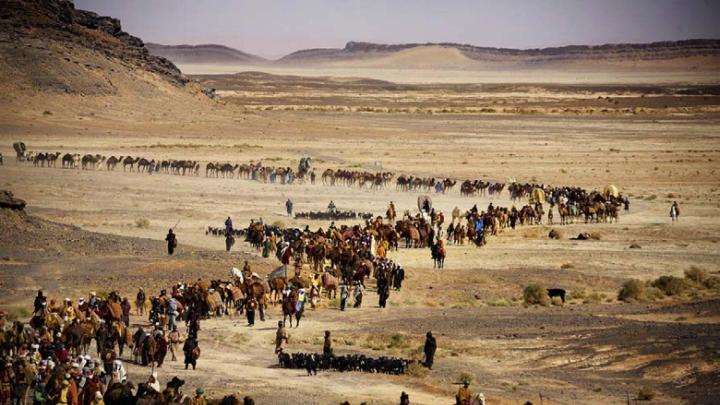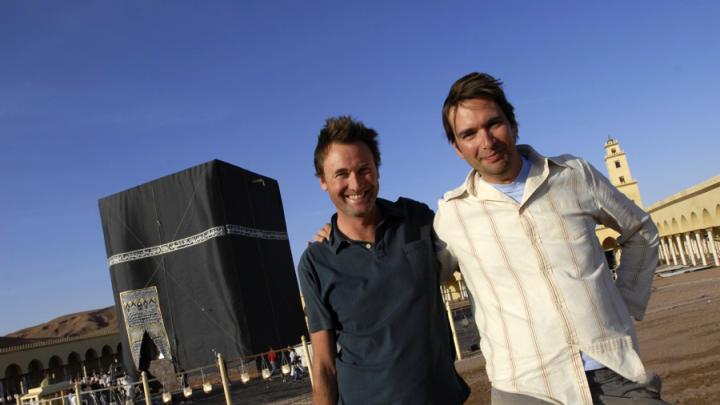In one stunning shot, we fly just above a caravan of camels--320 camels, to be exact, joined by 660 donkeys, sheep, and goats and 500 humans in a vast, winding procession across the desert. At another point, a howling sandstorm makes us want to squeeze our eyes shut. The union of high-tech film hardware with ancient landscapes gives Journey to Mecca, a 45-minute IMAX movie now on world tour, the feel of a Cecil B. De Mille picture raised to the fourth power.
It includes unprecedented images--like the first footage shot inside Mecca’s Grand Mosque, and the sight of two million pilgrims gathered on the plains of Arafat during the hajj, the 1,400-year-old pilgrimage to Mecca that every Muslim endeavors to make at least once. And that camel caravan is the longest in film history. The 70-millimeter IMAX format has “been used, for example, to present great events in space and underwater,” says Taran Davies ’93, the movie’s co-producer. “The hajj is one of the great cultural and spiritual events on earth, but one which most of us know far less about than we do about things that happen in outer space and under the sea.”
Davies first made documentary films at Harvard, and after college rode horseback with some classmates around Lake Baikal in Siberia, filming Around the Sacred Sea (see July-August 1995, page 52). Travels in Central Asian nations like Uzbekistan and Tajikistan led to The Land Beyond the River, which PBS aired. In 1996 he switched to finance with Loeb Partners on Wall Street, but the 9/11 attacks, from which Davies fled by bicycle, were “such a clear moment, in terms of what path I needed to take.” He grabbed his film camera and three weeks later was in Afghanistan; his Afghan Stories appeared in 2002. Davies’s wide travels, and those of his business partner, Dominic Cunningham-Reid, converged when they founded Cosmic Picture in 2004, and “All roads led to Mecca,” Davies explains.
Journey to Mecca took five years to make, and required no fewer than 85 permits from government agencies in Saudi Arabia; the diplomatic process of building relationships was one that Cunningham-Reid summarizes as “a million cups of tea.” Cosmic Picture also raised the $13-million budget from an international corps of investors, hired actor Ben Kingsley to narrate, made a distribution deal with the National Geographic Society, and booked the January 2009 world premiere in Abu Dhabi. In coming months, Journey to Mecca will show at the Smithsonian Institution, at the American Museum of Natural History in New York City, and in Philadelphia, Baltimore, and other American cities. Endorsed by both the Dalai Lama and the archbishop of Canterbury, the film has drawn audiences in Kuwait, Indonesia, Saudi Arabia, South Africa, and Canada.
Non-Muslims like Davies and Cunningham-Reid cannot enter the holy city, so they trained two all-Islamic camera crews to shoot images like the spectacular aerial shot of thousands of pilgrims circling the Ka‘ba, the black cubical building in the center of Mecca that is the most sacred site in Islam. (Islamic tradition holds that Abraham [Ibrahim] built the first structure on the site, and all Muslims face the Ka‘ba when praying. Abraham’s centrality indicates, as Davies explains, that the hajj actually connects with Jewish and Christian, as well as Islamic, traditions.)
Journey to Mecca tells its story by dramatizing the pilgrimage of Ibn Battuta, who set out from Tangier in 1325 and arrived in Mecca 18 months later. (He then kept voyaging, for 29 years and 75,000 miles more, becoming the best-traveled person of antiquity--and also the only person to have both a crater on the moon and a mall in Dubai named after him.) His hajj, described in his memoir, the Rihla, waited only seven centuries to find its way onto the big screen.










